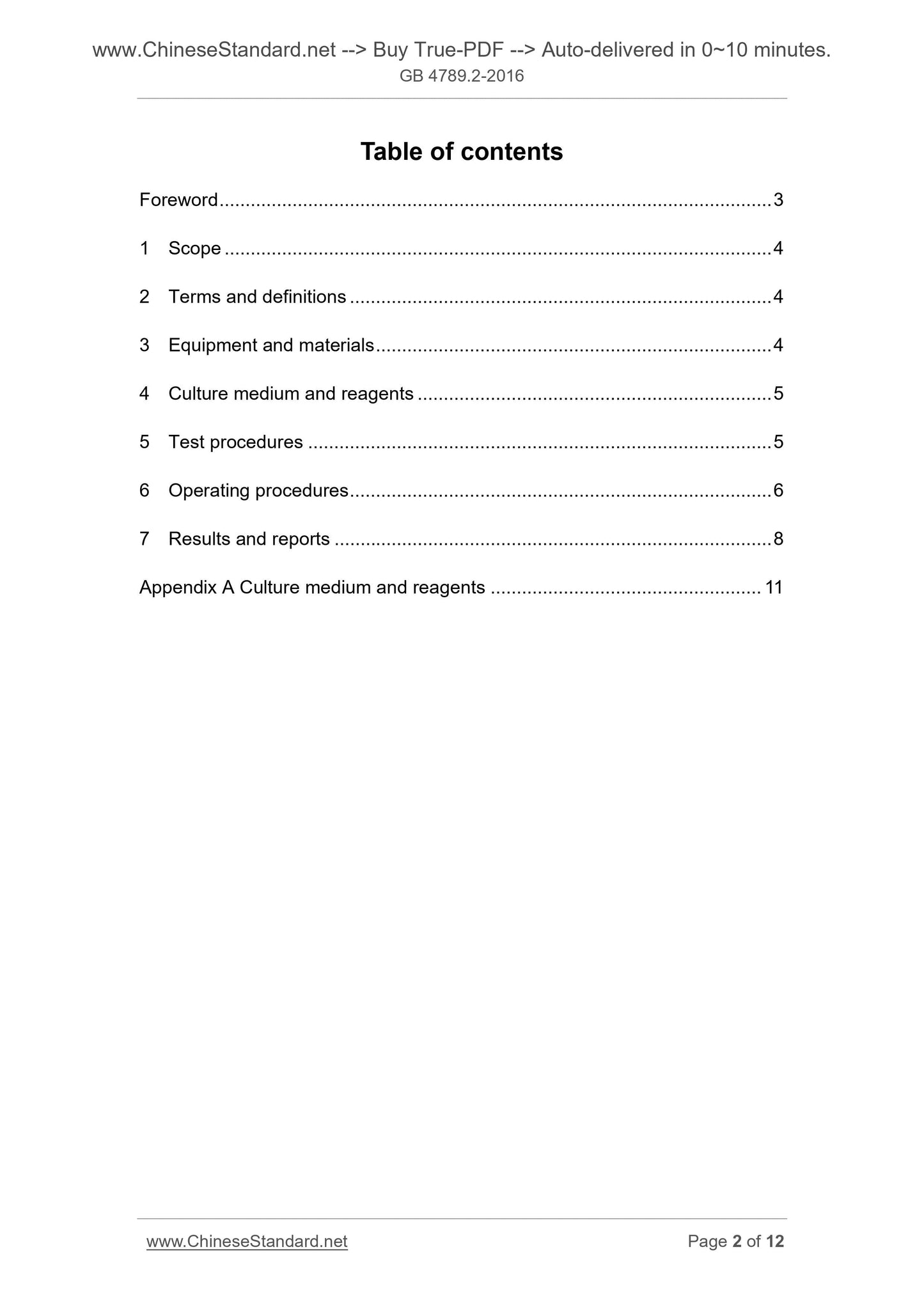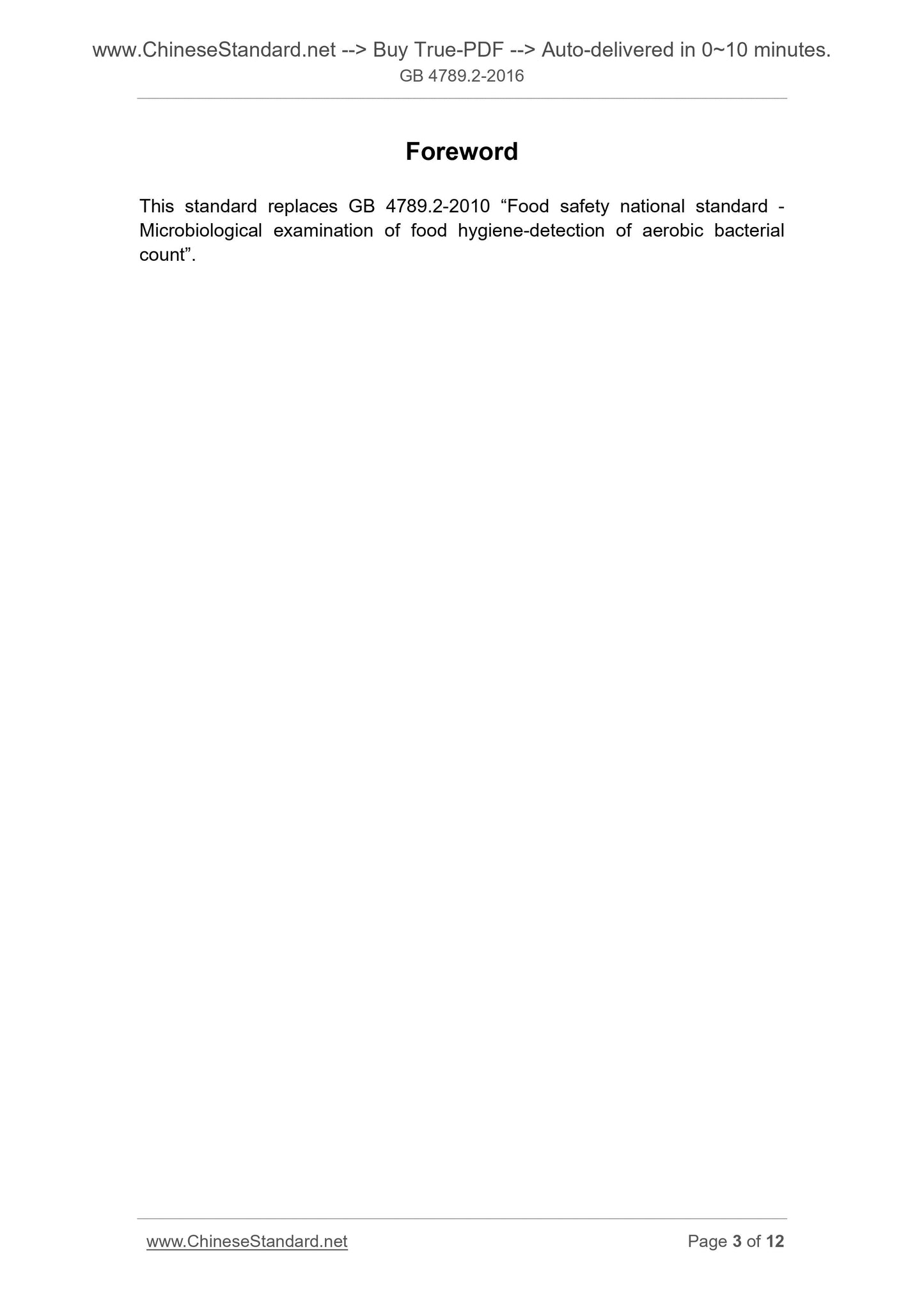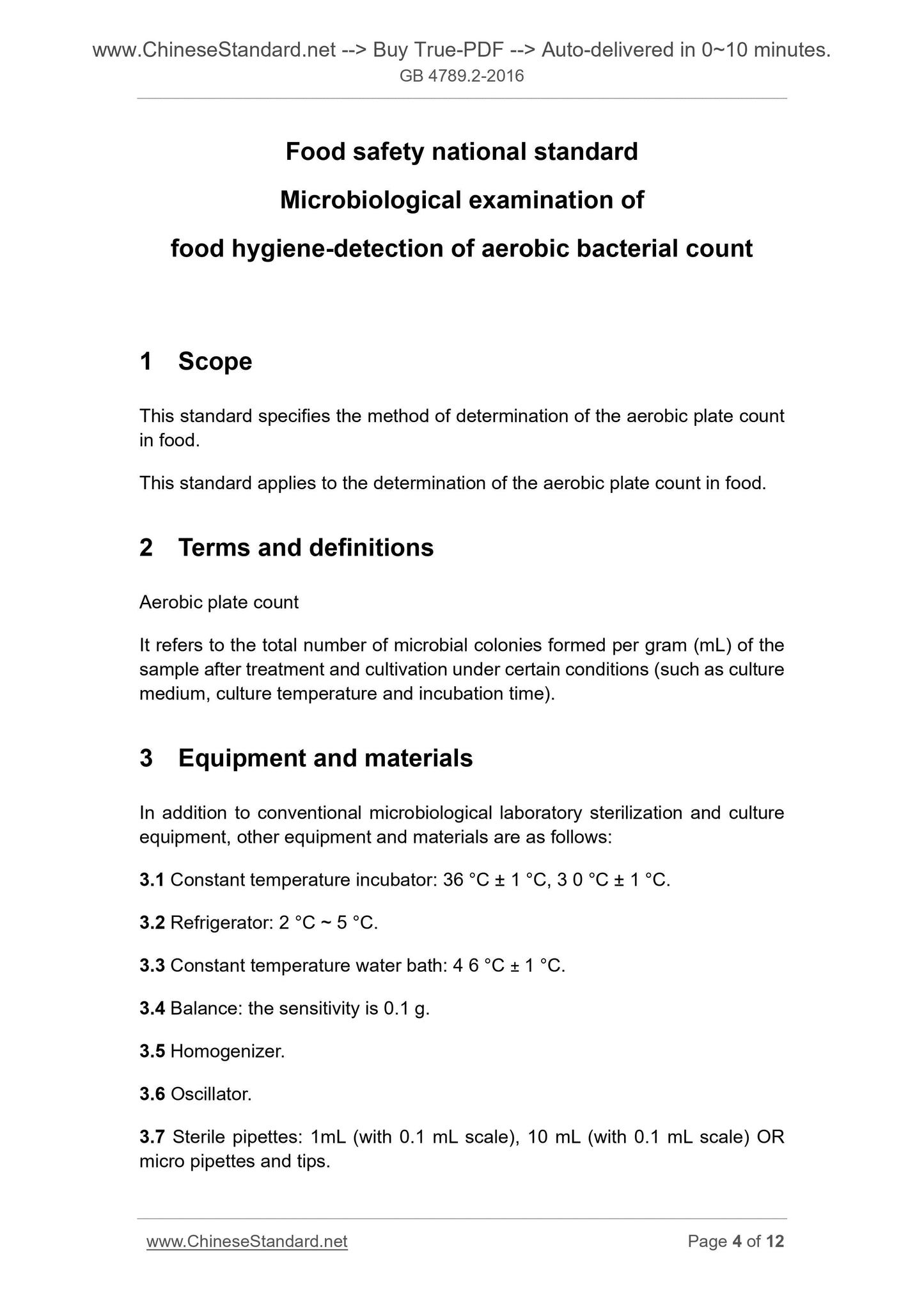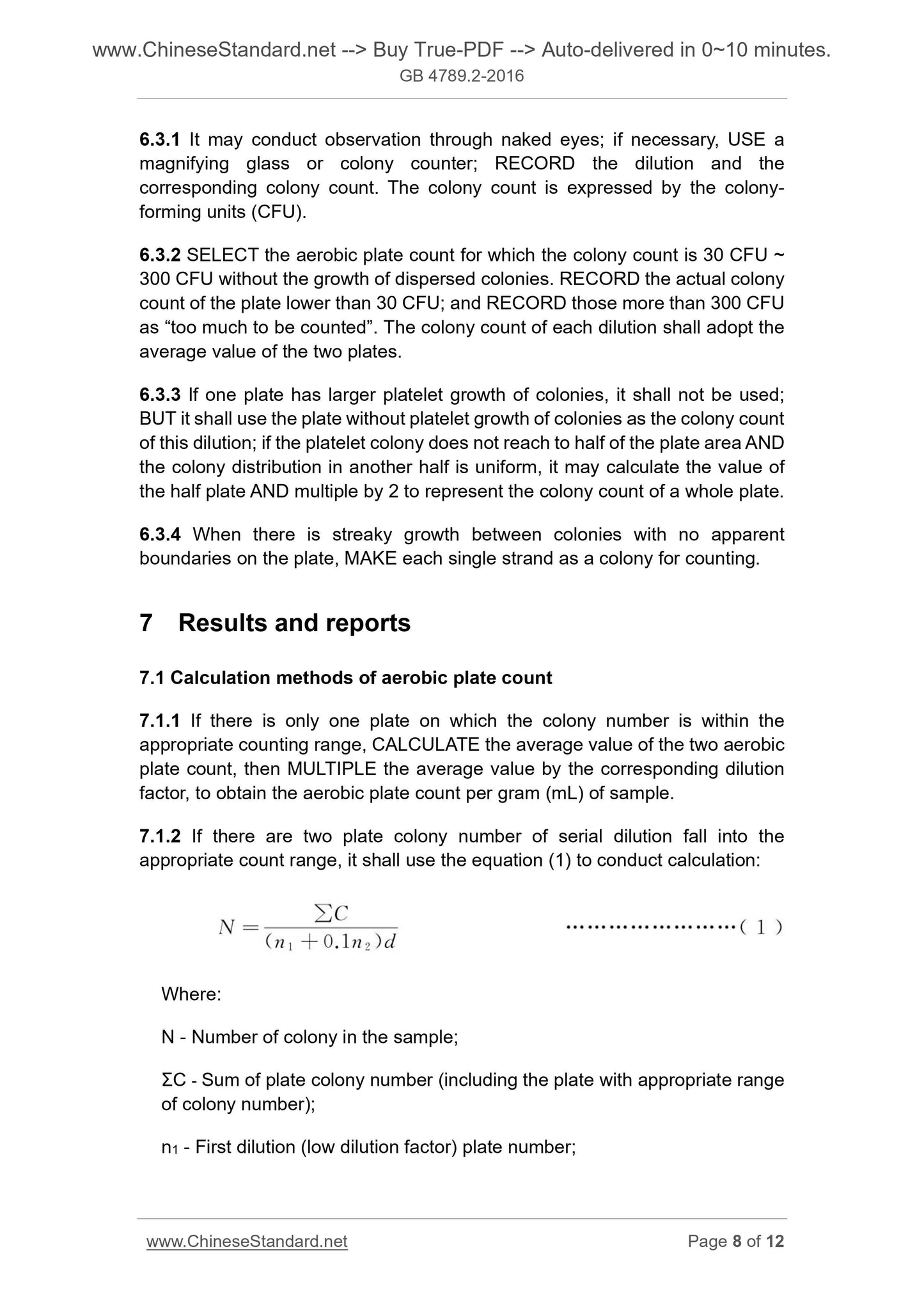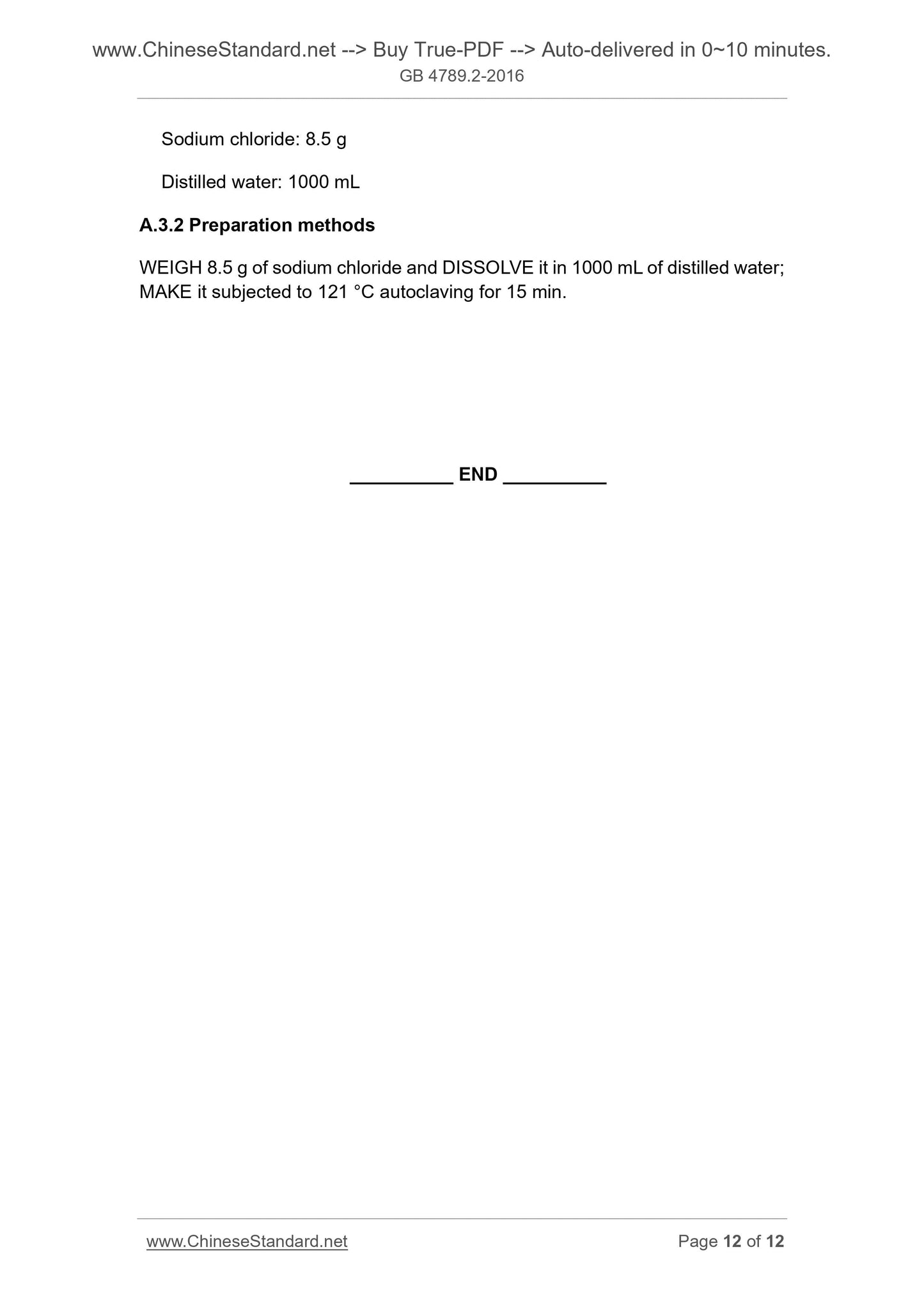1
/
of
6
PayPal, credit cards. Download editable-PDF & invoice in 1 second!
GB 4789.2-2016 English PDF
GB 4789.2-2016 English PDF
Regular price
$70.00
Regular price
Sale price
$70.00
Unit price
/
per
Shipping calculated at checkout.
Couldn't load pickup availability
GB 4789.2-2016: National food safety standard -- Food microbiological examination -- Aerobic plate count
Delivery: 9 seconds. Download (and Email) true-PDF + Invoice.
Newer version: (Replacing this standard) GB 4789.2-2022
Get Quotation: Click GB 4789.2-2016 (Self-service in 1-minute)
Historical versions (Master-website): GB 4789.2-2022
Preview True-PDF (Reload/Scroll-down if blank)
GB 4789.2-2016
GB
NATIONAL STANDARD
OF THE PEOPLE’S REPUBLIC OF CHINA
Food safety national standard
Microbiological examination of
food hygiene-detection of aerobic bacterial count
ISSUED ON. DECEMBER 23, 2016
IMPLEMENTED ON. JUNE 23, 2017
Issued by. National Health and Family Planning Commission of People’s
Republic of China;
State Food and Drug Administration.
Table of contents
Foreword ... 3
1 Scope ... 4
2 Terms and definitions ... 4
3 Equipment and materials ... 4
4 Culture medium and reagents ... 5
5 Test procedures ... 5
6 Operating procedures ... 6
7 Results and reports ... 8
Appendix A Culture medium and reagents ... 11
Foreword
This standard replaces GB 4789.2-2010 “Food safety national standard -
Microbiological examination of food hygiene-detection of aerobic bacterial
count”.
Food safety national standard
Microbiological examination of
food hygiene-detection of aerobic bacterial count
1 Scope
This standard specifies the method of determination of the aerobic plate count
in food.
This standard applies to the determination of the aerobic plate count in food.
2 Terms and definitions
Aerobic plate count
It refers to the total number of microbial colonies formed per gram (mL) of the
sample after treatment and cultivation under certain conditions (such as culture
medium, culture temperature and incubation time).
3 Equipment and materials
In addition to conventional microbiological laboratory sterilization and culture
equipment, other equipment and materials are as follows.
3.1 Constant temperature incubator. 36 °C ± 1 °C, 3 0 °C ± 1 °C.
3.2 Refrigerator. 2 °C ~ 5 °C.
3.3 Constant temperature water bath. 4 6 °C ± 1 °C.
3.4 Balance. the sensitivity is 0.1 g.
3.5 Homogenizer.
3.6 Oscillator.
3.7 Sterile pipettes. 1mL (with 0.1 mL scale), 10 mL (with 0.1 mL scale) OR
micro pipettes and tips.
6.3.1 It may conduct observation through naked eyes; if necessary, USE a
magnifying glass or colony counter; RECORD the dilution and the
corresponding colony count. The colony count is expressed by the colony-
forming units (CFU).
6.3.2 SELECT the aerobic plate count for which the colony count is 30 CFU ~
300 CFU without the growth of dispersed colonies. RECORD the actual colony
count of the plate lower than 30 CFU; and RECORD those more than 300 CFU
as “too much to be counted”. The colony count of each dilution shall adopt the
average value of the two plates.
6.3.3 If one plate has larger platelet growth of colonies, it shall not be used;
BUT it shall use the plate without platelet growth of colonies as the colony count
of this dilution; if the platelet colony does not reach to half of the plate area AND
the colony distribution in another half is uniform, it may calculate the value of
the half plate AND multiple by 2 to represent the colony count of a whole plate.
6.3.4 When there is streaky growth between colonies with no apparent
boundaries on the plate, MAKE each single strand as a colony for counting.
7 Results and reports
7.1 Calculation methods of aerobic plate count
7.1.1 If there is only one plate on which the colony number is within the
appropriate counting range, CALCULATE the average value of the two aerobic
plate count, then MULTIPLE the average value by the corresponding dilution
factor, to obtain the aerobic plate count per gram (mL) of sample.
7.1.2 If there are two plate colony number of serial dilution fall into the
appropriate count range, it shall use the equation (1) to conduct calculation.
Where.
N - Number of colony in the sample;
ΣC - Sum of plate colony number (including the plate with appropriate range
of colony number);
n1 - First dilution (low dilution factor) plate number;
Sodium chloride. 8.5 g
Distilled water. 1000 mL
A.3.2 Preparation methods
WEIGH 8.5 g of sodium chloride and DISSOLVE it in 1000 mL of distilled water;
MAKE it subjected to 121 °C autoclaving for 15 min.
GB 4789.2-2016
GB
NATIONAL STANDARD
OF THE PEOPLE’S REPUBLIC OF CHINA
Food safety national standard
Microbiological examination of
food hygiene-detection of aerobic bacterial count
ISSUED ON. DECEMBER 23, 2016
IMPLEMENTED ON. JUNE 23, 2017
Issued by. National Health and Family Planning Commission of People’s
Republic of China;
State Food and Drug Administration.
Table of contents
Foreword ... 3
1 Scope ... 4
2 Terms and definitions ... 4
3 Equipment and materials ... 4
4 Culture medium and reagents ... 5
5 Test procedures ... 5
6 Operating procedures ... 6
7 Results and reports ... 8
Appendix A Culture medium and reagents ... 11
Foreword
This standard replaces GB 4789.2-2010 “Food safety national standard -
Microbiological examination of food hygiene-detection of aerobic bacterial
count”.
Food safety national standard
Microbiological examination of
food hygiene-detection of aerobic bacterial count
1 Scope
This standard specifies the method of determination of the aerobic plate count
in food.
This standard applies to the determination of the aerobic plate count in food.
2 Terms and definitions
Aerobic plate count
It refers to the total number of microbial colonies formed per gram (mL) of the
sample after treatment and cultivation under certain conditions (such as culture
medium, culture temperature and incubation time).
3 Equipment and materials
In addition to conventional microbiological laboratory sterilization and culture
equipment, other equipment and materials are as follows.
3.1 Constant temperature incubator. 36 °C ± 1 °C, 3 0 °C ± 1 °C.
3.2 Refrigerator. 2 °C ~ 5 °C.
3.3 Constant temperature water bath. 4 6 °C ± 1 °C.
3.4 Balance. the sensitivity is 0.1 g.
3.5 Homogenizer.
3.6 Oscillator.
3.7 Sterile pipettes. 1mL (with 0.1 mL scale), 10 mL (with 0.1 mL scale) OR
micro pipettes and tips.
6.3.1 It may conduct observation through naked eyes; if necessary, USE a
magnifying glass or colony counter; RECORD the dilution and the
corresponding colony count. The colony count is expressed by the colony-
forming units (CFU).
6.3.2 SELECT the aerobic plate count for which the colony count is 30 CFU ~
300 CFU without the growth of dispersed colonies. RECORD the actual colony
count of the plate lower than 30 CFU; and RECORD those more than 300 CFU
as “too much to be counted”. The colony count of each dilution shall adopt the
average value of the two plates.
6.3.3 If one plate has larger platelet growth of colonies, it shall not be used;
BUT it shall use the plate without platelet growth of colonies as the colony count
of this dilution; if the platelet colony does not reach to half of the plate area AND
the colony distribution in another half is uniform, it may calculate the value of
the half plate AND multiple by 2 to represent the colony count of a whole plate.
6.3.4 When there is streaky growth between colonies with no apparent
boundaries on the plate, MAKE each single strand as a colony for counting.
7 Results and reports
7.1 Calculation methods of aerobic plate count
7.1.1 If there is only one plate on which the colony number is within the
appropriate counting range, CALCULATE the average value of the two aerobic
plate count, then MULTIPLE the average value by the corresponding dilution
factor, to obtain the aerobic plate count per gram (mL) of sample.
7.1.2 If there are two plate colony number of serial dilution fall into the
appropriate count range, it shall use the equation (1) to conduct calculation.
Where.
N - Number of colony in the sample;
ΣC - Sum of plate colony number (including the plate with appropriate range
of colony number);
n1 - First dilution (low dilution factor) plate number;
Sodium chloride. 8.5 g
Distilled water. 1000 mL
A.3.2 Preparation methods
WEIGH 8.5 g of sodium chloride and DISSOLVE it in 1000 mL of distilled water;
MAKE it subjected to 121 °C autoclaving for 15 min.
Delivery: 9 seconds. Download (and Email) true-PDF + Invoice.
Newer version: (Replacing this standard) GB 4789.2-2022
Get Quotation: Click GB 4789.2-2016 (Self-service in 1-minute)
Historical versions (Master-website): GB 4789.2-2022
Preview True-PDF (Reload/Scroll-down if blank)
GB 4789.2-2016
GB
NATIONAL STANDARD
OF THE PEOPLE’S REPUBLIC OF CHINA
Food safety national standard
Microbiological examination of
food hygiene-detection of aerobic bacterial count
ISSUED ON. DECEMBER 23, 2016
IMPLEMENTED ON. JUNE 23, 2017
Issued by. National Health and Family Planning Commission of People’s
Republic of China;
State Food and Drug Administration.
Table of contents
Foreword ... 3
1 Scope ... 4
2 Terms and definitions ... 4
3 Equipment and materials ... 4
4 Culture medium and reagents ... 5
5 Test procedures ... 5
6 Operating procedures ... 6
7 Results and reports ... 8
Appendix A Culture medium and reagents ... 11
Foreword
This standard replaces GB 4789.2-2010 “Food safety national standard -
Microbiological examination of food hygiene-detection of aerobic bacterial
count”.
Food safety national standard
Microbiological examination of
food hygiene-detection of aerobic bacterial count
1 Scope
This standard specifies the method of determination of the aerobic plate count
in food.
This standard applies to the determination of the aerobic plate count in food.
2 Terms and definitions
Aerobic plate count
It refers to the total number of microbial colonies formed per gram (mL) of the
sample after treatment and cultivation under certain conditions (such as culture
medium, culture temperature and incubation time).
3 Equipment and materials
In addition to conventional microbiological laboratory sterilization and culture
equipment, other equipment and materials are as follows.
3.1 Constant temperature incubator. 36 °C ± 1 °C, 3 0 °C ± 1 °C.
3.2 Refrigerator. 2 °C ~ 5 °C.
3.3 Constant temperature water bath. 4 6 °C ± 1 °C.
3.4 Balance. the sensitivity is 0.1 g.
3.5 Homogenizer.
3.6 Oscillator.
3.7 Sterile pipettes. 1mL (with 0.1 mL scale), 10 mL (with 0.1 mL scale) OR
micro pipettes and tips.
6.3.1 It may conduct observation through naked eyes; if necessary, USE a
magnifying glass or colony counter; RECORD the dilution and the
corresponding colony count. The colony count is expressed by the colony-
forming units (CFU).
6.3.2 SELECT the aerobic plate count for which the colony count is 30 CFU ~
300 CFU without the growth of dispersed colonies. RECORD the actual colony
count of the plate lower than 30 CFU; and RECORD those more than 300 CFU
as “too much to be counted”. The colony count of each dilution shall adopt the
average value of the two plates.
6.3.3 If one plate has larger platelet growth of colonies, it shall not be used;
BUT it shall use the plate without platelet growth of colonies as the colony count
of this dilution; if the platelet colony does not reach to half of the plate area AND
the colony distribution in another half is uniform, it may calculate the value of
the half plate AND multiple by 2 to represent the colony count of a whole plate.
6.3.4 When there is streaky growth between colonies with no apparent
boundaries on the plate, MAKE each single strand as a colony for counting.
7 Results and reports
7.1 Calculation methods of aerobic plate count
7.1.1 If there is only one plate on which the colony number is within the
appropriate counting range, CALCULATE the average value of the two aerobic
plate count, then MULTIPLE the average value by the corresponding dilution
factor, to obtain the aerobic plate count per gram (mL) of sample.
7.1.2 If there are two plate colony number of serial dilution fall into the
appropriate count range, it shall use the equation (1) to conduct calculation.
Where.
N - Number of colony in the sample;
ΣC - Sum of plate colony number (including the plate with appropriate range
of colony number);
n1 - First dilution (low dilution factor) plate number;
Sodium chloride. 8.5 g
Distilled water. 1000 mL
A.3.2 Preparation methods
WEIGH 8.5 g of sodium chloride and DISSOLVE it in 1000 mL of distilled water;
MAKE it subjected to 121 °C autoclaving for 15 min.
GB 4789.2-2016
GB
NATIONAL STANDARD
OF THE PEOPLE’S REPUBLIC OF CHINA
Food safety national standard
Microbiological examination of
food hygiene-detection of aerobic bacterial count
ISSUED ON. DECEMBER 23, 2016
IMPLEMENTED ON. JUNE 23, 2017
Issued by. National Health and Family Planning Commission of People’s
Republic of China;
State Food and Drug Administration.
Table of contents
Foreword ... 3
1 Scope ... 4
2 Terms and definitions ... 4
3 Equipment and materials ... 4
4 Culture medium and reagents ... 5
5 Test procedures ... 5
6 Operating procedures ... 6
7 Results and reports ... 8
Appendix A Culture medium and reagents ... 11
Foreword
This standard replaces GB 4789.2-2010 “Food safety national standard -
Microbiological examination of food hygiene-detection of aerobic bacterial
count”.
Food safety national standard
Microbiological examination of
food hygiene-detection of aerobic bacterial count
1 Scope
This standard specifies the method of determination of the aerobic plate count
in food.
This standard applies to the determination of the aerobic plate count in food.
2 Terms and definitions
Aerobic plate count
It refers to the total number of microbial colonies formed per gram (mL) of the
sample after treatment and cultivation under certain conditions (such as culture
medium, culture temperature and incubation time).
3 Equipment and materials
In addition to conventional microbiological laboratory sterilization and culture
equipment, other equipment and materials are as follows.
3.1 Constant temperature incubator. 36 °C ± 1 °C, 3 0 °C ± 1 °C.
3.2 Refrigerator. 2 °C ~ 5 °C.
3.3 Constant temperature water bath. 4 6 °C ± 1 °C.
3.4 Balance. the sensitivity is 0.1 g.
3.5 Homogenizer.
3.6 Oscillator.
3.7 Sterile pipettes. 1mL (with 0.1 mL scale), 10 mL (with 0.1 mL scale) OR
micro pipettes and tips.
6.3.1 It may conduct observation through naked eyes; if necessary, USE a
magnifying glass or colony counter; RECORD the dilution and the
corresponding colony count. The colony count is expressed by the colony-
forming units (CFU).
6.3.2 SELECT the aerobic plate count for which the colony count is 30 CFU ~
300 CFU without the growth of dispersed colonies. RECORD the actual colony
count of the plate lower than 30 CFU; and RECORD those more than 300 CFU
as “too much to be counted”. The colony count of each dilution shall adopt the
average value of the two plates.
6.3.3 If one plate has larger platelet growth of colonies, it shall not be used;
BUT it shall use the plate without platelet growth of colonies as the colony count
of this dilution; if the platelet colony does not reach to half of the plate area AND
the colony distribution in another half is uniform, it may calculate the value of
the half plate AND multiple by 2 to represent the colony count of a whole plate.
6.3.4 When there is streaky growth between colonies with no apparent
boundaries on the plate, MAKE each single strand as a colony for counting.
7 Results and reports
7.1 Calculation methods of aerobic plate count
7.1.1 If there is only one plate on which the colony number is within the
appropriate counting range, CALCULATE the average value of the two aerobic
plate count, then MULTIPLE the average value by the corresponding dilution
factor, to obtain the aerobic plate count per gram (mL) of sample.
7.1.2 If there are two plate colony number of serial dilution fall into the
appropriate count range, it shall use the equation (1) to conduct calculation.
Where.
N - Number of colony in the sample;
ΣC - Sum of plate colony number (including the plate with appropriate range
of colony number);
n1 - First dilution (low dilution factor) plate number;
Sodium chloride. 8.5 g
Distilled water. 1000 mL
A.3.2 Preparation methods
WEIGH 8.5 g of sodium chloride and DISSOLVE it in 1000 mL of distilled water;
MAKE it subjected to 121 °C autoclaving for 15 min.
Share

